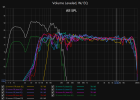rrahmanucla
Member
- Joined
- May 8, 2020
- Messages
- 13
- Likes
- 3
Being a long time follower on this thread, I wanted to get some insights from the ASR community on mixing speaker brands. Most traditional advice suggests mixing speaker brands in a home theater is not preferred, because differences in timbre or other characteristics of the speaker would interfere with sounds panning across the screen, overhead, laterally, or behind. That being said, the trend it seems on ASR (and my personally opinion) is that the majority of what needs to be known about a how speaker sounds can be ascertained by objective CEA 2034 measurements and that speakers w/ good measurements e.g. KEF, Neumann, Genelec, Revel etc sound more alike than different. So my next thought is that the traditional dogma of mixing home theater speakers for the specific subset of well measured speakers should not apply.
So what do people think? Are these speakers good/similar enough that picking a different brand for surround vs fronts or ceiling vs the rest is inaudible? Is there anything I should look at in the CEA 2034 measurements to suggest two manufacturers would pair better or worse, e.g. slope of the sound power curve?
So what do people think? Are these speakers good/similar enough that picking a different brand for surround vs fronts or ceiling vs the rest is inaudible? Is there anything I should look at in the CEA 2034 measurements to suggest two manufacturers would pair better or worse, e.g. slope of the sound power curve?


